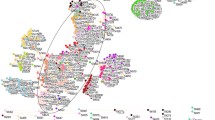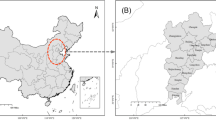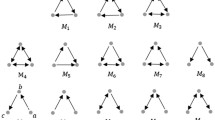Abstract
Air pollution, particularly PM2.5 particulate matter, is a significant issue in Santiago, the capital of Chile. Santiago’s pollution problem is exacerbated by its unique geographic location nestled against the Andes mountain range in the central valley of Chile. This paper uses network models that were developed primarily to analyze systemic risk in the financial system to identify those locations in the city that are most important for explaining PM2.5 levels. High average concentrations are associated with both systemically important locations and those that are most sensitive to pollution arriving from other areas. A detailed picture of the links across the city can help direct official efforts to combat pollution.




Similar content being viewed by others
Notes
For the adverse impacts of PM2.5 in European cities, see Maciejewska (2020).
For a general introduction to time series modeling using VARs, see Martin et al. (2013), Chapters 13 and 14.
See Acharya et al. (2016) for the potential to introduce bias by using potentially endogenous variables in this setting.
For ease of interpretation, the monitoring stations are ordered in the VAR in south-west to north-east order according to their geographic location given that this is the direction of the prevailing wind across Santiago.
References
Acharya A, Blackwell M, Sen M (2016) Explaining causal findings without bias: Detecting and assessing direct effects. Am Pol Sci Rev 110(3):512–529. https://doi.org/10.1017/S0003055416000216
Cifuentes L (2010) Relación de la Norma de Calidad Primaria PM2.5 con la Norma de Calidad Primaria de PM10. Tech rep., Comision Nacional del Medio Ambiente, Region Metropolitana de Santiago
Díaz-Robles L, Ortega J, Fu J, Reed G, Chow J, Watson J, Moncada J (2008) A hybrid ARIMA and artificial neural networks model to forecast particulate matter in urban areas: The case of temuco, Chile. Atmos. Environ. 42(35):8331–8340. https://doi.org/10.1016/j.atmosenv.2008.07.020
Diebold F, Yilmaz K (2014) On the network topology of variance decompositions: Measuring the connectedness of financial firms. Journal of Econometrics 182:119–134.
Feng X, Li Q, Zhu Y, Hou J, Jin L, Wang J (2015) Artificial neural networks forecasting of PM 2.5 pollution using air mass trajectory based geographic model and wavelet transformation. Atmos. Environ. 107:118–128. https://doi.org/10.1016/j.atmosenv.2015.02.030
Gajardo S (2016) Pobreza y distribución del ingreso en la región metropolitana de santiago: Resultados encuesta casen 2015. Seremi de Desarrollo Social Metropolitana
Gramsch E (2014) Actualización y sistematización del inventario de emisiones de contaminantes atmosféricos en la región metropolitana. Ministerio del Medio Ambiente
Henriquez A, Osses A, Gallardo L, Diaz Resquin M (2015) Analysis and optimal design of air quality monitoring networks using a variational approach. Tellus B: Chemical and Physical Meteorology 67 (1):25,385. https://doi.org/10.3402/tellusb.v67.25,385
INE (2015) Census 2015. National Statistics Institute (INE) Chile
Kurt A, Oktay A (2010) Forecasting air pollutant indicator levels with geographic models 3 days in advance using neural networks. Expert Systems with Applications 37(12):7986–7992. https://doi.org/10.1016/j.eswa.2010.05.093
Liang Z, Zhou C, Yang F, Che L, Wang B, Sun D (2019) Spatio-temporal evolution and the influencing factors of PM2.5 in China between 2000 and 2015. J Geographical Sci (2):253–270. https://doi.org/10.1007/s11442-019-1595-0
Maciejewska K (2020) Short-term impact of PM2.5, PM10, and PMc on mortality and morbidity in the agglomeration of Warsaw Poland, Air Quality, Atmosphere & Health, https://doi.org/10.1007/s11869-020-00831-9
Martin V, Hurn A, Harris D (2013) Econometric modelling with time series. Cambridge University Press, New York
MMA (2011) Norma primaria de calidad ambiental para material particulado fino respirable PM 2.5 Reporte Oficial, Tech. rep., Ministerio del Medio Ambiente
Moisan S, Herrera R, Clements A (2018) A dynamic multiple equation approach for forecasting PM2.5 pollution in Santiago, Chile. Int. J. Forecast. 34:566–581. https://doi.org/10.1016/j.ijforecast.2018.03.007
Molina C, Toro A, Morales R, Manzano C, Leiva-Guzman M (2017) Particulate matter in urban areas of south-central Chile exceeds air quality standards. Air Quality, Atmosphere & Health 10(5). https://doi.org/10.1007/s11869-017-0459-y
Nicolis O, Díaz M, Sahu S, Marín J (2019) Bayesian spatio-temporal modeling for estimating short-term exposure to air pollution in Santiago de Chile. Environmetrics 30(7):e2574. https://onlinelibrary.wiley.com/doi/abs/10.1002/env.2574
Osses A, Gallardo L, Faundez T (2013) Analysis and evolution of air quality monitoring networks using combined statistical information indexes. Tellus B: Chemical and Physical Meteorology 65(1):19822. https://doi.org/10.3402/tellusb.v65i0.19822
Perez P, Gramsch E (2016) Forecasting hourly PM2.5 in Santiago de Chile with emphasis on night episodes. Atmospheric Environment 124:22–27. https://doi.org/10.1016/j.atmosenv.2015.11.016
Perez P, Reyes J (2006) An integrated neural network model for PM10 forecasting. Atmos. Environ. 40(16):2845–2851. https://doi.org/10.1016/j.atmosenv.2006.01.010
Pino-Cortés E, Díaz-Robles L, Campos V, Vallejo F, Gómez J, Cereceda-Balic F, Fu J, Figueroa J (2020) Effect of socioeconomic status on the relationship between short-term exposure to PM2.5 and cardiorespiratory mortality and morbidity in a megacity: the case of Santiago de Chile. Air Quality, Atmosphere & Health 13(5). https://doi.org/10.1007/s11869-020-00818-6
Sahu S, Gelfand A, Holland D (2006) Spatio-temporal modeling of fine particulate matter. Journal of Agricultural, Biological, and Environmental Statistics 11:61–86. https://doi.org/10.1198/108571106X95746
Saide P, Carmichael G, Spak S, Gallardo L, Osses A, Mena M, Pagowski M (2011) Forecasting urban PM 10 and PM 2.5 pollution episodes in very stable nocturnal conditions and complex terrain using wrf–chem co tracer model. Atmos. Environ. 45(16):2769–2780. https://doi.org/10.1016/j.atmosenv.2011.02.001
Saide P, Mena M, Tolvett S, Hernandez P, Carmichael G (2016) Air quality forecasting for winter-time PM 2.5 episodes occurring in multiple cities in central and southern Chile. J Geophys Res Atmos 121 (1):558–575. https://doi.org/10.1002/2015JD023949
SINIA (2010) Análisis del impacto económico y social de la norma de calidad primaria de material particulado 2.5. Tech. rep., Sistema Nacional de Información Ambiental
Funding
The first author received financial support from the Chilean CONICYT funding agency (FONDECYT 1180672).
Author information
Authors and Affiliations
Corresponding author
Additional information
Publisher’s note
Springer Nature remains neutral with regard to jurisdictional claims in published maps and institutional affiliations.
Rights and permissions
About this article
Cite this article
Clements, A., Herrera, R. & Hurn, S. Network analysis: a novel approach to identify PM2.5 hotspots and their spatio-temporal impact on air quality in Santiago de Chile. Air Qual Atmos Health 13, 1075–1082 (2020). https://doi.org/10.1007/s11869-020-00862-2
Received:
Accepted:
Published:
Issue Date:
DOI: https://doi.org/10.1007/s11869-020-00862-2




